Last updated on August 20, 2025
The ultimate guide to the Google Shopping auction
Google Shopping ads offer a great opportunity to showcase your products and drive traffic to your site. But how do these ads get placed in front of the right people at the right time? The answer lies in understanding the Google Shopping auction process.
In this guide, we’ll break down how the auction works and share some practical tips for improving your product visibility, increasing your chances of being seen, and ultimately driving more sales.
Feed attributes and their impact on your ads
When Google evaluates which ads to show, it looks at the following factors:
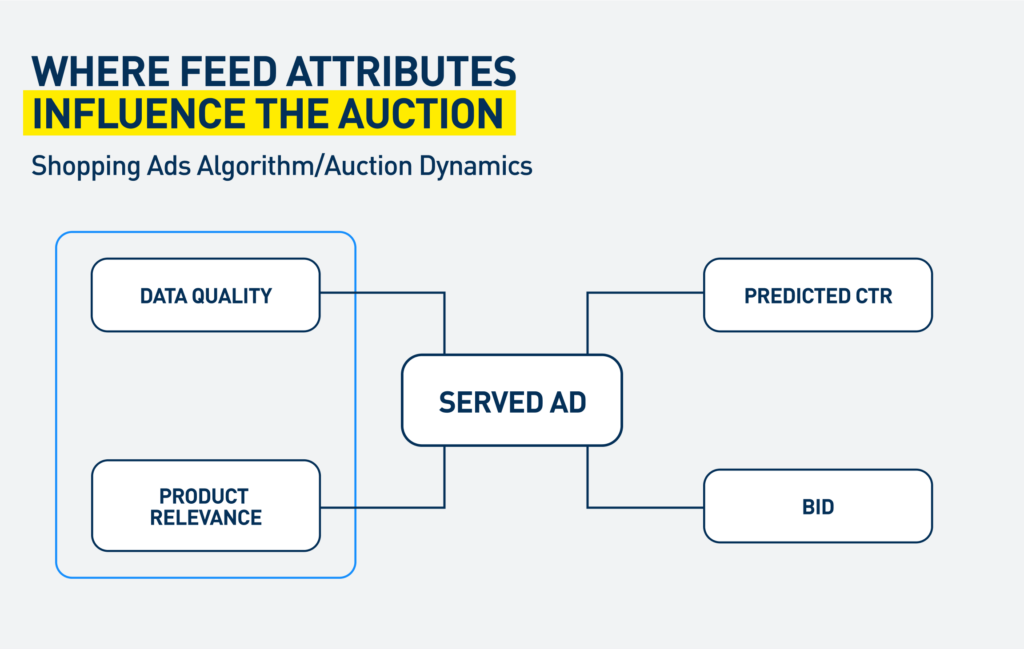
- Data Quality: This is the most important factor. Google compares your product data to the user’s search terms. The more relevant your product is to the user’s search, the better your chances of ranking higher.
- Product relevance: Google will evaluate your ad’s overall quality, including how well it matches the search query and user intent. Ads with more relevant and engaging content tend to rank better in the auction.
- Predicted CTR: Google estimates your ad’s click-through rate using various historical and contextual signals, including:
– Historical click-through performance of the ad and similar ads
– Keyword relevance to the ad
– Device and location context
– Search terms that triggered the ad
Avoid searching for your own ads on Google without clicking them, as it can damage your campaign performance. Google may interpret this behaviour as a lack of interest from users in similar circumstances, which lowers your predicted CTR over time.
A lower predicted CTR can hurt your Quality Score and Ad Rank, leading to reduced ad visibility and higher CPC. On top of that, this behaviour also sends misleading signals to Google’s Smart Bidding algorithm, which relies on signals like device, location, time, and user behaviour to adjust your bids.
If these signals become associated with non-engagement, Google’s system may start bidding less aggressively in those contexts, even when your ad is highly relevant. To avoid this, use the Ad Preview and Diagnosis Tool in Google Ads, to check whether your ads are being shown, without influencing CTR or Smart Bidding data.
Data quality and product relevance
Google distinguishes two types of impact on the auction; Back-end and front-end.
Back end impact refers to how product attributes affect visibility and eligibility in search results. It determines how well your product matches user queries within Google Shopping ads.
Front end impact relates to how product attributes affect the CTR and user engagement. It’s about how attractive and convincing your product appears in the ad interface.
Every attribute in your product feed affects auction performance, but not all have the same weight on the back-end or front-end. Understanding which attributes have the greatest impact allows you to focus your optimization efforts where they matter most.
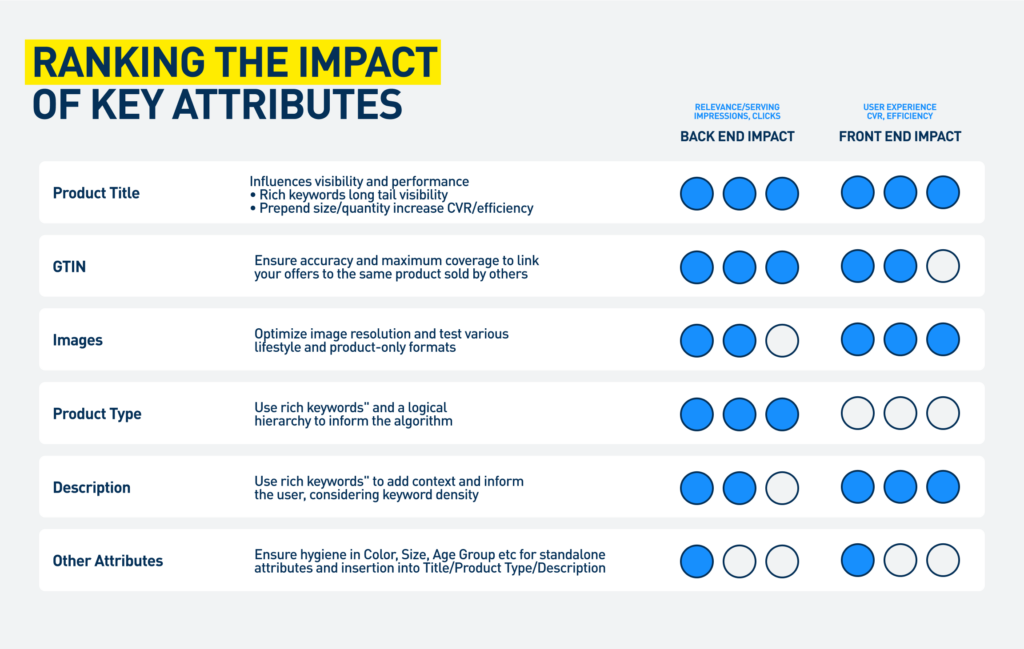
1. Product title
- Back-end impact: Product titles play a big role in how your product ranks in Google’s system, affecting relevance, serving, impressions, and clicks. Using strong keywords helps improve visibility and match your product to the right searches. For example, if you sell a “Blue Nike Running Shoe Size 10,” the title should include important keywords like “Nike”, “Running Shoe”, and the size.
- Front-end impact: On the front-end, product titles impact the user experience, conversion rate (CVR), and efficiency. A clear, keyword-rich title will make it easier for users to understand what the product is and encourage them to click on it. For example, “Nike Running Shoes for Men, Size 10, Blue” clearly tells users what they’re looking at.
When optimizing your product titles, make sure to follow the recommended structure for your specific industry to maximize relevance and performance:
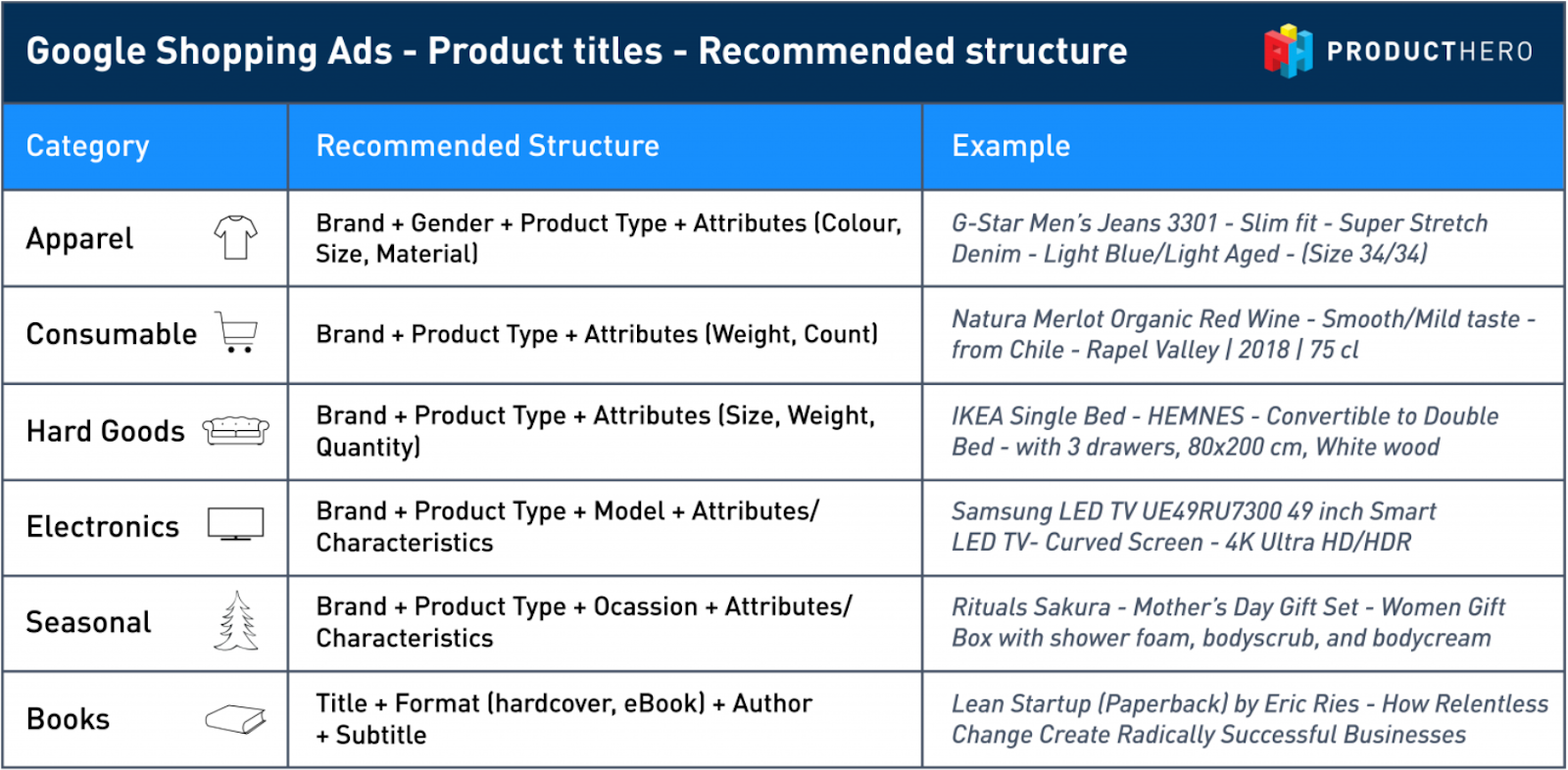
2. GTIN (Global Trade Item Number)
- Back-end impact: Adding a GTIN to your product helps Google match it with the same product sold by other retailers. This makes it more likely your ad will show up in the right searches. For example, if you’re selling a Nike running shoe with a GTIN that matches other listings, Google will group them together. That means better visibility and more chances for your ad to appear.
Google also uses GTINs to create benchmark data reports, as the price is also part of the auction. Price benchmark data is also implemented in the Producthero platform, and can be used to segment your campaigns.
- Front-end impact: GTINs aren’t shown to users, but they help ensure accurate listings, which can lead to better product match results and, ultimately, more clicks. Since users will see the most relevant results for their searches, it enhances the chance of conversion.
3. Images
- Back-end impact: Images help Google’s algorithm optimize the resolution and categorize your product based on lifestyle, usage, and format. Google prefers high-quality images that match its standards.
- Front-end impact: High-quality images improve user experience, CTR, and ultimately conversions. Users are more likely to click on your ad when they see a clear, well-lit image of the product that shows its features. For example, if you’re selling a backpack, an image showing the backpack in use (e.g., on a hiking trip) can attract more clicks compared to a plain product shot on a white background. You can use the lifestyle_image_link for images that show how users interact with your products.
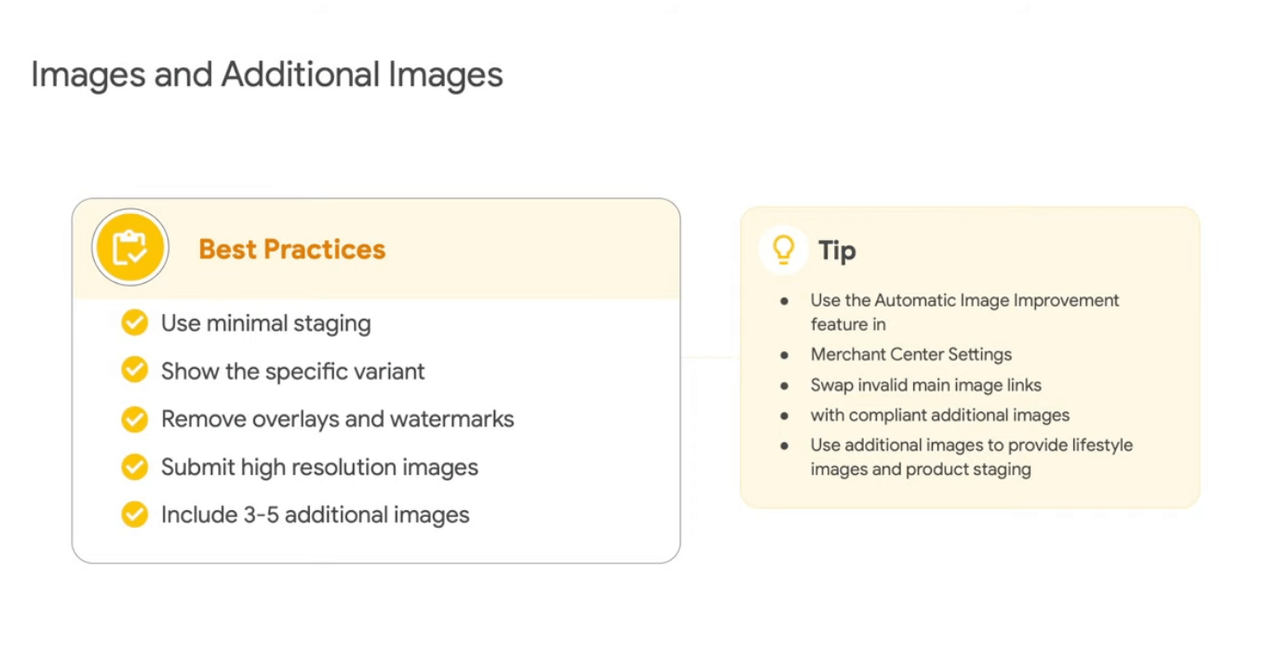
4. Product Type
- Back-end impact: This tells Google what your product is and how it fits into broader categories. By using rich keywords in the product type (e.g., “Sports Water Bottle” or “Eco-Friendly Stainless Steel Water Bottle”), you help Google categorize your product more effectively. This improves your ad’s relevance in the auction, which boosts impressions and the chances your ad will be served to the right audience.
- Front-end impact: The product_type is not visible to users, and therefore it doesn’t have any front-end impact.
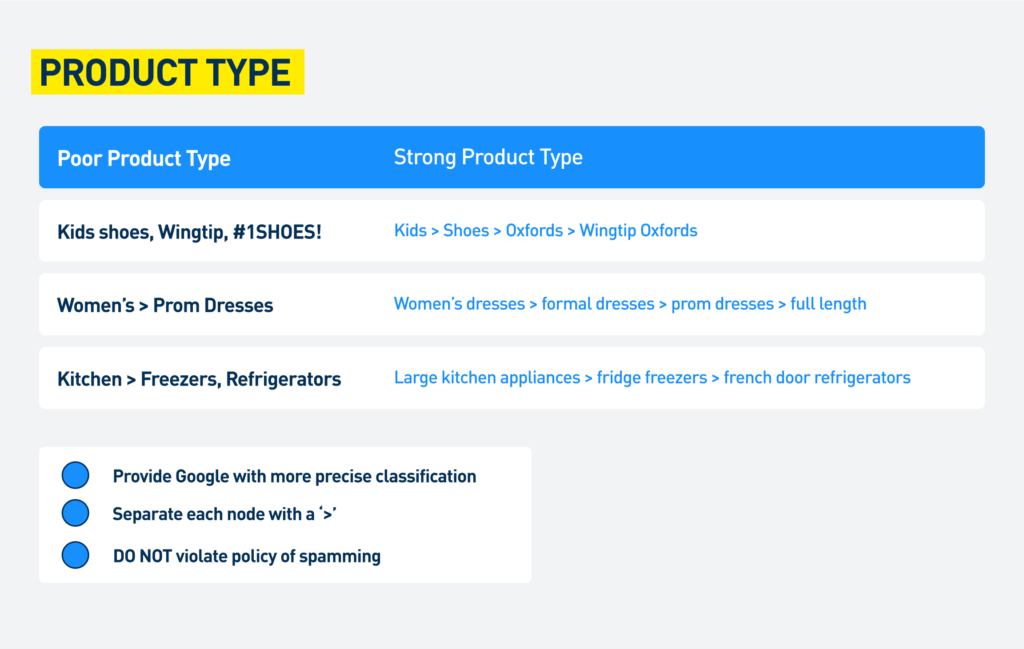
5. Description
- Back-end impact: The description helps Google’s algorithm better understand your product and improve its relevancy for specific search queries. Using keywords in the product description allows Google to serve your ad to users searching for those terms.
- Front-end impact: On the front-end, an informative description impacts users experience, encouraging them to click on your ad. It also influences the conversion rate (CVR) and overall efficiency.
6. Other Attributes
- Back-end impact: Other product attributes like colour, size, age group, and material help inform Google’s algorithm, making it easier to categorize and serve your product to the right audience. For instance, if you sell a “red cotton T-shirt,” the colour and material attributes help Google match your product with users searching for specific styles or types of clothing. These attributes are also used as filters in the search results.
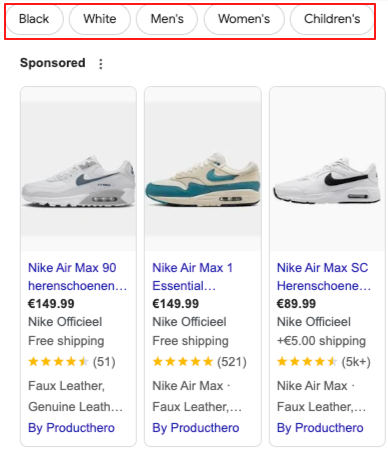
- Front-end impact: On the front-end, these attributes can improve the user experience by providing more specific details that help users make better purchase decisions. If a user is searching for a “red cotton T-shirt,” the product’s specific attributes help match them with exactly what they are looking for, improving conversion rates.
With our tool Products AI, you can automatically improve all relevant feed attributes, boosting your visibility in the auction and improving relevancy. Our Products AI scoring model is based around the most important feed attributes according to Google:
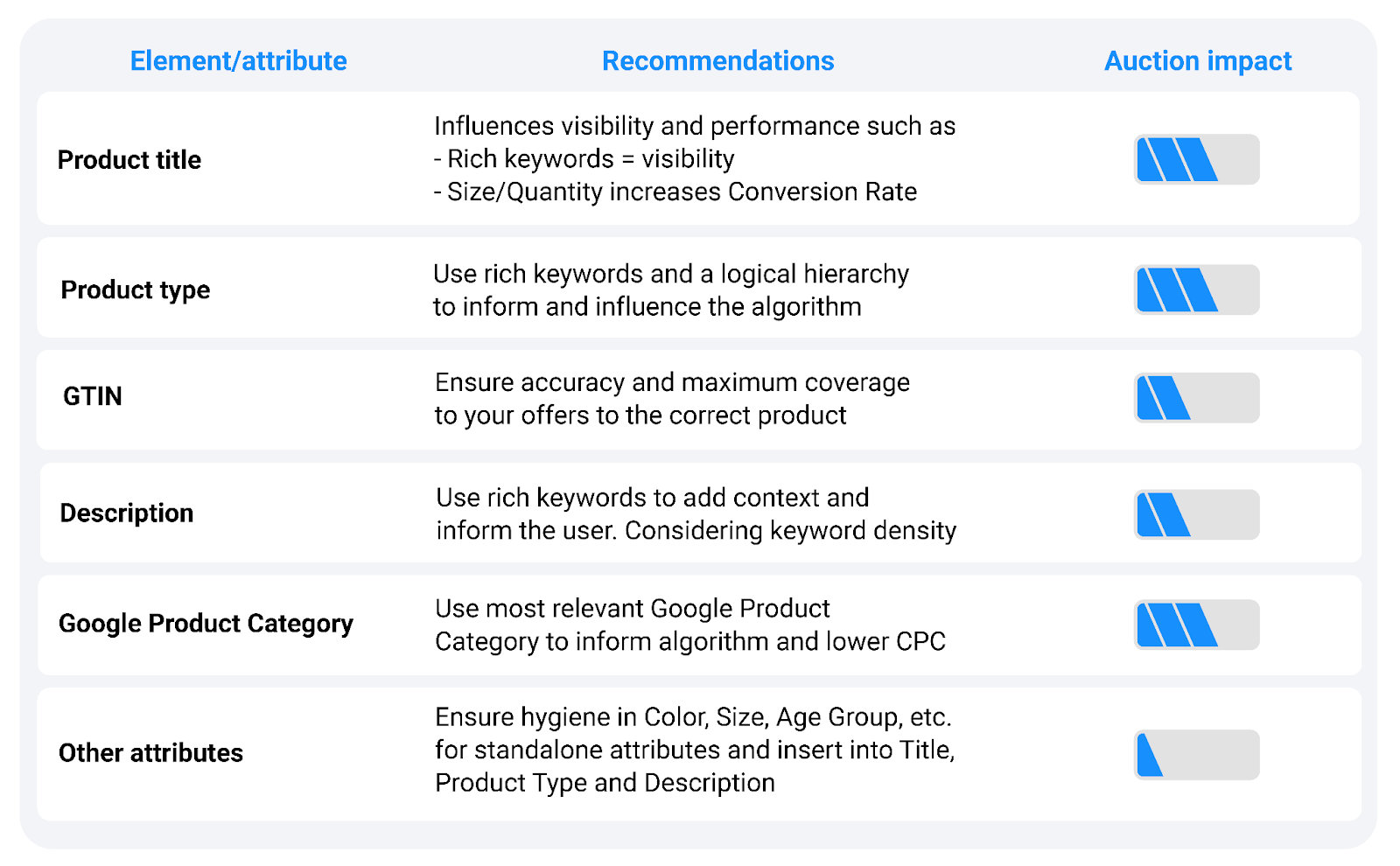
Bidding Signals
The Google Shopping auction uses a variety of bidding signals to determine which products will appear in search results. These signals are categorized into three layers, from the most important (the inner circle) to supporting signals (outer circles).
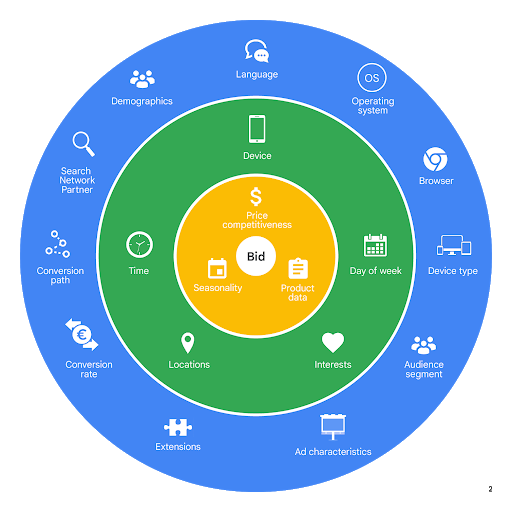
Inner circle: The core bidding signals
These are the primary factors that have the most direct impact on ad performance in the Shopping auction. If you want your product ads to show more often, and in better positions, focus on optimizing these.
- Bid: Your bid is the amount you’re willing to pay for an ad impression or click, and, while important, it’s not everything. Google will consider the bid alongside other factors like product data and ad quality. A high bid alone won’t guarantee the best ranking if other signals aren’t optimized.
- Product Data: In Google Search ads, advertisers choose specific keywords to trigger their ads. In Shopping ads, there are no keywords. Instead, Google uses your product feed to match your listings to relevant queries. It analyzes product attributes alongside your bid and past performance to decide which ads appear, in what order, and at what cost.
- Price Competitiveness: Automated bidding strategies may adjust your bid based on how your product’s price compares to similar offers from other advertisers. If your product is priced more competitively, Smart Bidding may choose to bid more aggressively to help you win the auction and attract more clicks.
Since bidding strategies like Target ROAS and Maximize Conversion Value take price competitiveness into account, knowing how your prices compare to others can help you take better advantage of demand.
- Seasonality: Some products are more popular at certain times of the year, like holiday decorations, summer clothes, or special gifts. Increasing your bids during these times can help your products stay visible when more people are searching. For example, you might raise your bids around Black Friday or Christmas. When demand goes up, more advertisers compete for clicks, which can push CPCs higher. Adjusting your bids helps you ensure your products remain visible in the crowded auction.
Middle circle: Additional bidding signals
These are secondary signals that still have an impact but are considered less critical than the core factors in the inner circle. These factors also function as bid modifiers in standard shopping campaigns.
- Device: Google takes the user’s device into account when deciding which ads to show. Behaviour often differs between mobile, desktop, and tablet. Mobile users tend to make quicker decisions, so increasing bids on mobile can improve results for fast-selling products. Desktop users are more likely to buy higher-priced items, so higher bids on desktop can help when promoting expensive products. Adjusting bids by device helps match your strategy to how users behave on each platform.
- Location: Where a user is located can have an impact on how your ads perform. If your product is relevant to certain regions or markets, Google will take that into account and adjust bids accordingly. For instance, if you’re selling premium or high-end products, you might see better conversion rates in areas with higher average incomes and Smart Bidding will respond to that by bidding more competitively in those regions.
- Day of the Week / Time of Day: The time and day when people shop can also affect how your ads perform. Shoppers are often more active in the evenings or on weekends. Adjusting your bids to match these peak periods can boost your product’s visibility when people are more likely to convert.
- Interests: The kinds of topics, products, or services a user is actively engaging with online. These interests are determined by Google based on a person’s browsing behaviour, video views, search history, and interactions across the web.
Outer circle: Supporting signals
These signals play a role in refining the bidding strategy, but are less influential than the core and secondary signals. They help improve targeting and ad relevance.
- Demographics: Google uses demographic data such as age, gender, household income, and parental status to identify user groups more likely to convert. Based on this, Smart Bidding adjusts your bids to focus more on users who fit your ideal customer profile, so your ads reach the people most likely to convert.
- Language: The language setting of a user’s browser or search helps tailor ads and bidding strategies to users who are more likely to engage with content in that language. For example, if your campaign performs better with Dutch-speaking users, Smart Bidding takes that into account.
- Operating System (OS): The OS being used (e.g., Android, iOS, Windows, macOS) can affect performance. Some products or websites may perform better on certain systems due to speed, compatibility, or app integration, which Smart Bidding will factor in.
- Browser: Different browsers (Chrome, Safari, Firefox, Edge, etc.) may impact conversion behaviour. Google adjusts bids depending on past performance data tied to these browsers.
- Device Type: This includes whether the user is on desktop, mobile, or tablet. Since user behaviour often varies by device, Smart Bidding can bid higher or lower accordingly.
- Audience Segment: These are custom or predefined groups based on behaviors, interests, or interactions with your business (like remarketing lists or in-market segments). Google uses this to identify people more likely to convert.
- Ad Characteristics: Smart Bidding can also take into account the structure and format of the ad, such as whether you’re using Dynamic search ads, image assets, or video for Performance Max. Certain formats may perform better with specific users or contexts.
- Extensions: If you’re using ad extensions like sitelinks, callouts, or price extensions, their presence can impact CTR and conversion likelihood.
- Conversion Rate: Google looks at the expected or historical conversion rate for a given auction and user profile. If a product has converted well before, Smart Bidding may increase the bid to improve your chances of showing the ad again.
- Conversion Path: This looks at how a user has interacted with your ads or website in the past. For example, if someone is returning after clicking on a previous ad, they’re more likely to convert, so Google may bid higher to reach them again.
- Search Network Partner: Your ad may show on Google Search partners (other search engines that use Google’s ad tech). Smart Bidding learns how performance varies across these and adjusts bids accordingly.
- Time: The time of day impacts conversions, some hours simply work better than others. Google uses past performance by hour to automatically raise or lower your bids at the right times.
The auction
When someone searches for a product on Google, an auction determines which Shopping ads appear, their order, and the cost per click. This real-time process considers factors like your bid, product data, and ad quality. Here’s a simplified breakdown of how that process works:
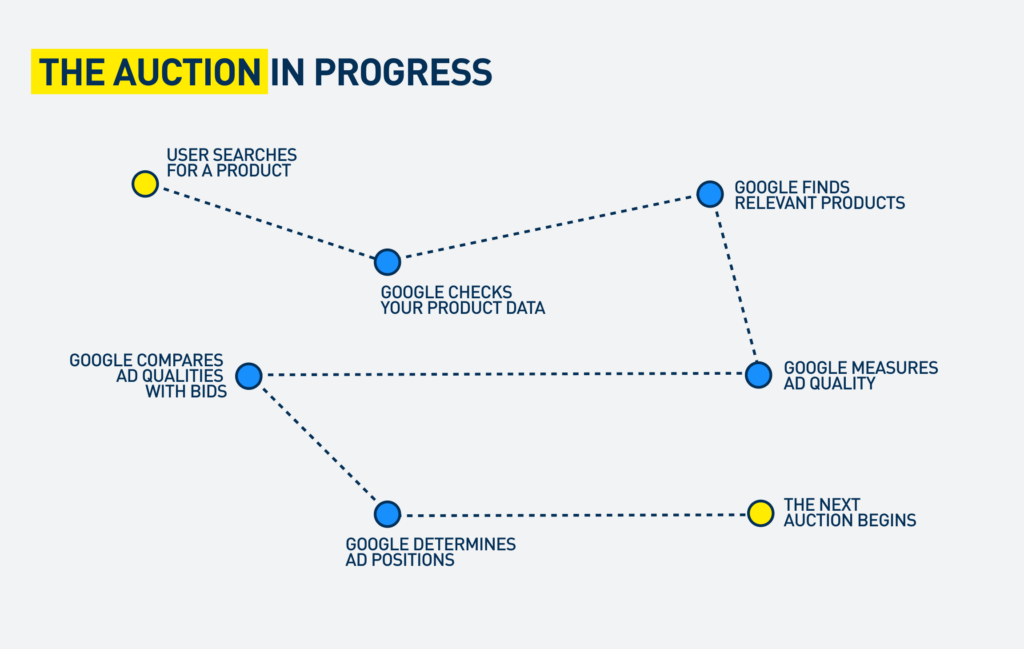
Producthero Framework
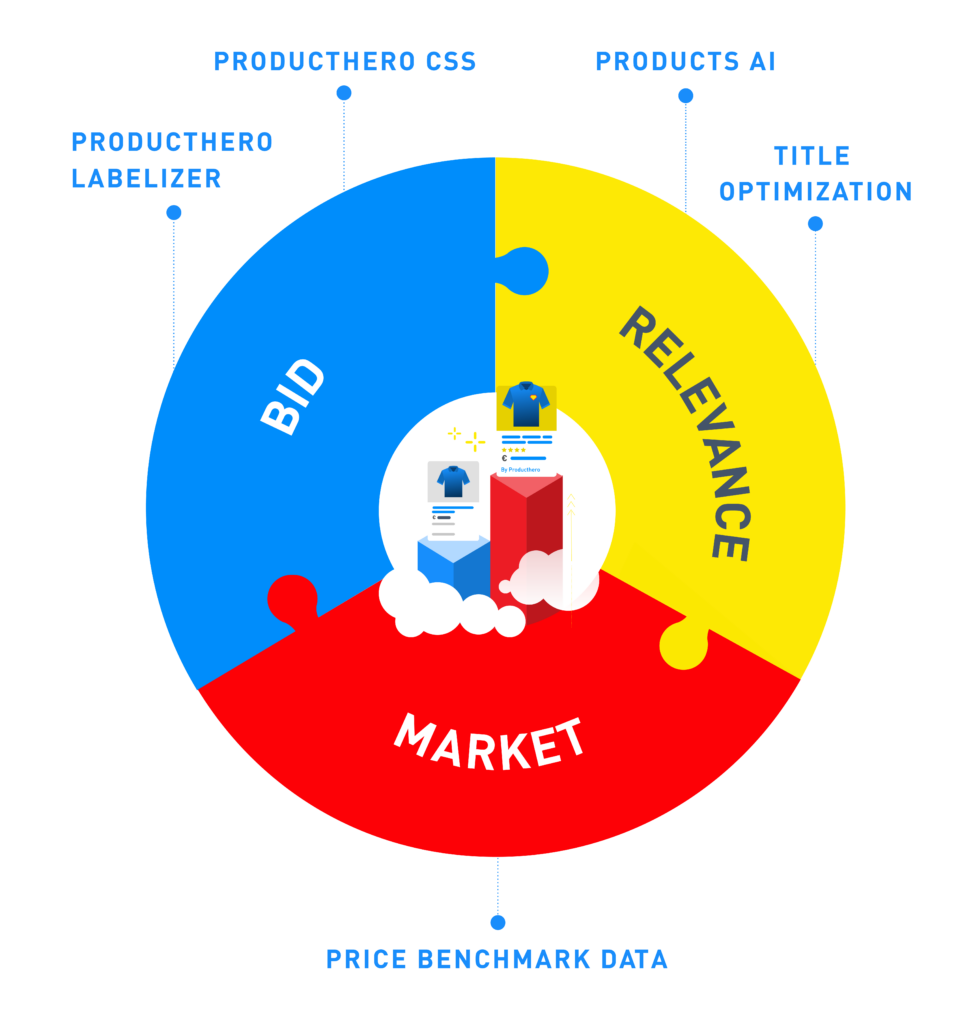
Now that you understand how the Google Shopping auction works, from data quality and click-through rates to feed attributes and bidding signals, you might be wondering how to put all of this into action.
That’s where the Producthero Framework comes in, bringing together all elements that affect how the Google Shopping auction works.
Our tools are built around the three shopping ads ranking factors (Bid, Relevance and Market) and are designed to help you improve ROAS and relevance, leading to greater visibility in Shopping results.
Find out more about our Platform and Tools on this page and start super boosting your Shopping ads performance today.

